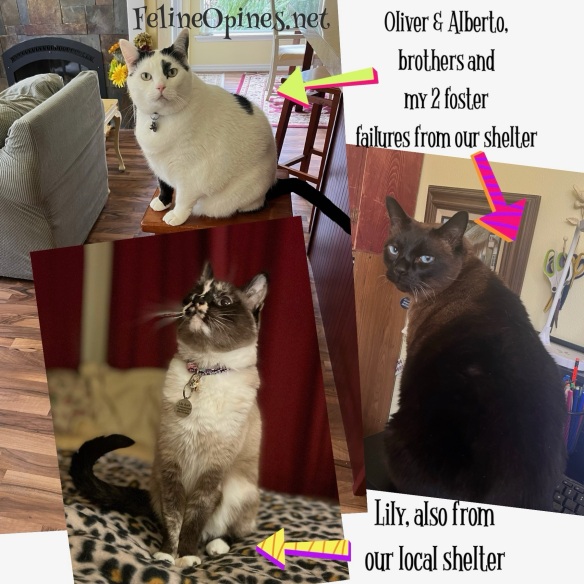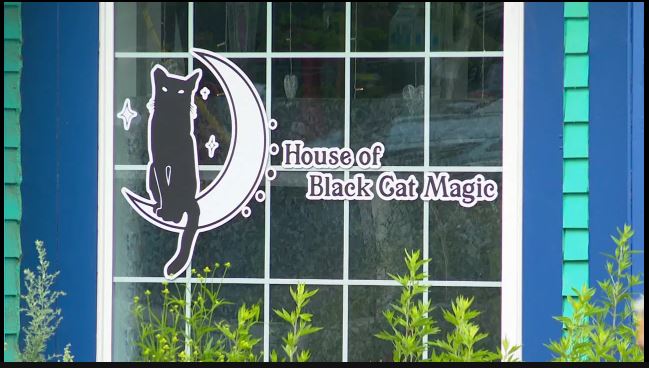
Hello Furiends,
It looks like it might be summer here, finally. I know some of you are suffering from the heat already and I hope your humans have air conditioning, fans or other cooling means available to you.
Did you know this is one of the best months of the year for kitties? June is National Adopt a Cat Month! Needless to say, the three shelter kitties in this home are thankful that The Human adopted us from our local shelter.
Oliver and I were foster “failures” and The Human says it’s a failure she’s thankful for. She was at an event at the shelter when one of the shelter board members introduced her to Lily and it was love at first sight. There are so many kitties waiting in shelters around the world for forever homes. Please consider bringing one home to your house!
Cat refuses to let human leave
I think all my feline furiends will agree that it’s nicer when our humans stay home with us. This kitty, caught in a TikTok video, foils his human’s attempt to leave the house in a hilarious way.
I would note that this is an orange cat (I recently shared an article about orange cats and how energetic they are). The cat takes possession of the human’s keys and hisses whenever she tries to take them off the table.
For all of you who don’t believe we felines are smart, BondVet recently declared that we have brains that allow us to problem solve, remember things in the past.
The humorous scene highlights cats’ intelligence and the attachment they can have toward their owners. According to BondVet, we felines have brains that allow us to solve problems, remember past events, and understand our human’s emotions. It’s said we have the intelligence of a human two year old.
In other words, this kitty who is guarding the keys knows exactly what he’s doing!
Cats May Be The Only Mammals Who Can’t Taste This 1 Flavor
Amy Glover at the Huff Post UK filed this interesting report about cats and our ability to taste sweet things. Have you ever wondered why your cat tries to steal a bite of your pizza but refuses to eat the expensive canned food you just bought him? What flavors motivate us? Well the Scientific American says that we felines are missing a vital protein that is necessary to taste sweets. The article says that the sweet receptor consists of two coupled proteins generated by two separate genes: known as Tas1r2 and Tas1r3,” We felines “lack 247 base pairs of the amino acids that make up the DNA of the Tas1r2 gene.”
What does that mean? We probably taste something when we eat sweets but we don’t taste what you humans do.
PetMD writes that cats are “seemingly alone among the mammal groups” with this evolutionary quirk regarding tasting sweets.
Despite this physical reality some of my feline friends seem to love sweets but experts say it’s probably the fat in the sweets, not the sugar that attracts them.
What tastes do we like? The article says we “also have interest in anything with animal protein in it (such as milk, cream, or ice cream), foods with strong smells, or warm food (the temperature of freshly killed prey),” they add ― and anything with a new mouth feel is likely to pique their curiosity.
And if you’re feeling bad that we can’t taste sweets, we do taste some flavors that you humans have, like adenosine triphosphate (ATP), a compound that provides energy for living cells.
Cat kidney transplants: For some, the pricey procedure is well worth it
We lost our dear Jasmine due to complications from kidney disease. The human gave her subQ fluids every other day, fed her special food and supplements but the disease took her away from us. For years kidney disease has just been a fact of life for older kitties but things are changing. This article by Marlene Cimons from The Washington Post brings news about kidney transplants for cats.
When the feline “Despy” suddenly developed a congenital form of advanced kidney disease at age 2 the veterinarian gave him only months to live. His human vowed to do whatever he could to save the cat. “He took care of me when I was sick,” says Segal, a software developer who lives in San Jose. “It was my turn to take care of him. It’s that’s simple.”
Segal, then living in the Boston area, drove his cat to the University of Pennsylvania School of Veterinary Medicine in Philadelphia where Despy underwent a kidney transplant in 2018. Today, Despy is thriving. So is Stevie, the kidney donor cat from a local shelter that Segal agreed to adopt as part of the renal transplant. He adores them both. “They play together, they groom each other, they roughhouse,” Segal says. “We’ve become a comfortable, loving family.”
Chronic kidney disease is one of the most common conditions in aging cats and a leading cause of death. It can also be inherited, which is what happened in Despy’s case, and can result from toxin exposure, such as eating lilies. (A cat who eats even a small amount from any part of a lily plant can suffer fatal kidney failure within days.)
Kidney transplants in cats began more than 25 years ago, although they still are rare, and only three facilities perform them: Penn Vet, the University of Wisconsin School of Veterinary Medicine and the University of Georgia College of Veterinary Medicine.
Penn Vet has performed 185 transplants since 1998, the Georgia school more than 40 since 2009, and Wisconsin 87 since 1996.
Not all cats are candidates for the procedure, and for those who are, it can be expensive, up to $25,000 for the surgeries to retrieve the donor kidney and transplant it into the recipient cat. Yet the surgeons who do them say they find it personally gratifying to give people more time with their cherished companions. Also, they add, the surgeries and long-term follow-up in cats can provide knowledge that potentially can benefit human health.
Most cats gain an average of two to three years, although there are exceptions. Despy, for example, is six years post-transplant. “Our longest survivor was nearly 13 years,” says Chad Schmiedt, the Alison Bradbury chair in feline health at the Georgia veterinary school. “Shilo was 3 when we did the transplant in June 2009 and lived until April 2022.”
About 40 percent “go out three years post-transplant,” says Robert J. Hardie, clinical professor of small-animal soft-tissue surgery at the Wisconsin veterinary school, adding that survival often depends on whether postsurgical complications occur. “Some live longer. We’ve had some out 10 years.” At Penn Vet, up to 70 percent are alive and doing well one year after transplant, and two recipients lived 13 years after the surgery.
“It is a life-expanding procedure with the possibility of relatively good outcomes — sometimes dramatic outcomes — in terms of longevity that is of great value to many pet parents,” Hardie says. Moreover, scientists could learn more about immunosuppression in cats that could be applicable to humans, he says.
The cats getting new kidneys typically are between the ages of 8 and 12, although younger cats without other potentially serious medical conditions often do better and live longer, experts say. Schmiedt usually won’t perform a transplant on a cat older than 16. Hardie says the oldest cat transplanted at Wisconsin was 18. Aronson once did one on a nearly 18-year-old who had no other health problems and was youthful in behavior and who lived for another two years with the new kidney.
Cats with moderate kidney disease are better candidates than those with mild or advanced disease, because of the balance between surgery risks and benefits, although age provides an advantage for young cats who may have advanced kidney disease. The cats also can’t have chronic infections or cancer because they must take the immunosuppressive drug cyclosporine for life, which can worsen both conditions. Severe heart disease also rules them out. “You want a recipient who has the best chance of making it” through surgery and beyond, Schmiedt says.
Matching is easier for cats than it is for humans needing a transplant because there are only two blood types among all cats.
Although this transplant is expensive it is still good news for kitties like Despy. His human says he’s full of energy and living his best life.
Kidney transplants for dogs is more challenging as dogs often suffer problems with immunosuppression.
Woman wakes up with four cats in bed with her. She only has three cats.
Anne-Sophie Mielke and Steffi Feldman from TAG24 provided this amusing story.
A Reddit user (username u/trixy_treat), shared a picture on the platform that has Reddit users talking. The lady who lives in Britain found herself snuggling in bed one morning with four cute felines who were nestled into her blankets and pillows. This woman sleeps with her cats so the sight was not unusual as she lives with three cats named, Pancake, the Tortie; Oreo, and Quinn. The fourth cat was not a member of her household but a visiting neighbor feline.
The visitor named Bluey, lives next door and is a buddy of her cat Quinn. The woman supposes that Bluely enjoys sleeping at her house because he lives with a large dog and a toddler.
If Bluey doesn’t sleep over he will appear at her window and meow loudly for her cats to come and play. Now it seems he’s graduated from morning play time to sleep overs.
House of Black Cat Magic celebrates 1 year of business, helping home 150 black cats
The House of Black Cat Magic in Asheville, N.C. hosts parties, community events and more in its Black Cat Lounge, giving people a chance to meet a variety of cats that are up for adoptions.
Joel SeymourSun from ABC13 News reported about their anniversary celebration, their first anniversary “purrty, “magical market” and a silent auction and cat food drive to benefit Binx’s Home for Black Cats food pantry.
Sterling “TrapKing” Davis, who runs TNR Humane Cat Solutions, was there to offer informative sessions about the importance of TNR programs — Trap, Neuter, Return — which help stabilize feral or community cat colonies by trapping them, then spaying or neutering them, and finally, returning the cats back to their community so they can live out their days without continuing to reproduce. We love Sterling, he is a rock star among his feline fans.
Sterling said about TNR, “”A lot of areas, they get a lot of cats so they overpopulate, they start fighting over resources, they end up getting sick, injured, harmful to one another,” Davis said. “So, it’s good to control the population in a good way… that’s what TNR is — you’ve got to spay and neuter your pets!”
I love humans who go above and beyond to help ferals and work to find forever homes for cats.
The Catio Guy
The Human does not support allowing us to go outside as there are all kinds of predators in our neck of the woods but she does provide the opportunity for us to sit on the upstairs patio in our own pop-up catio.
This guy custom builds cations and they are amazing. We definitely think this is a home renovation The Human should consider.
How many of my feline furiends out there can rock a skateboard like this guy?








